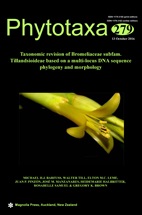Abstract
A taxonomic revision of Bromeliaceae subfam. Tillandsioideae is presented based on a multi-locus DNA sequence phylogeny (viz., plastid DNA loci rpoB-trnC-petN, trnK-matK-trnK, and ycf1, and the nuclear DNA gene PHYC) and new or re-evaluated morphology (e.g., leaf, inflorescence, sepal, petal, ovary, stigma, stamen, pollen, ovule, and seed morphology). This enables the circumscription of monophyletic units using synapomorphic combinations of diagnostic morphological characters. Stigma morphology has proven to be indicative for super-specific taxa in Tillandsioideae. One new stigma type and several subtypes of previously described stigmas were found. The four tribes proposed earlier are mostly confirmed, but Catopsideae replaces the formerly used name Pogospermeae for the monotypic tribe of Catopsis. In addition, the two new subtribes Cipuropsidinae and Vrieseinae are proposed within tribe Vrieseeae. Several new genera are established to render taxonomic units monophyletic and morphologically well circumscribed. They represent segregates of either Mezobromelia (Gregbrownia: 4 spp.), Tillandsia (viz., Barfussia: 3 spp., Josemania: 5 spp., Lemeltonia: 7 spp., Pseudalcantarea: 3 spp., and Wallisia: 4 spp. and 1 hybrid), or Vriesea (viz., Goudaea: 2 spp., Jagrantia: 1 sp., Lutheria: 4 spp., Stigmatodon: 18 spp., and Zizkaea: 1 spp.). The new subgenera Tillandsia subg. Pseudovriesea and T. subg. Viridantha are established, and T. subg. Aerobia is resurrected. An identification key to all accepted genera of Bromeliaceae subfam. Tillandsioideae is provided. Furthermore, to clarify nomenclatural uncertainties, typifications are proposed for Catopsis subg. Tridynandra, Thecophyllum [unranked] Biflorae, Tillandsia subg. Aerobia, T. sect. Caricifoliae, T. sect. Conostachys, T. sect. Cyathophora, T. sect. Eriophyllum, T. sect. Macrocyathus, T. sect. Platystachys Baker auct. non al., Tillandsia sect. Strepsia, Vriesea subg. Conostachys Mez auct. non al., T. lindenii K. Koch auct. non al., and T. macropetala.

